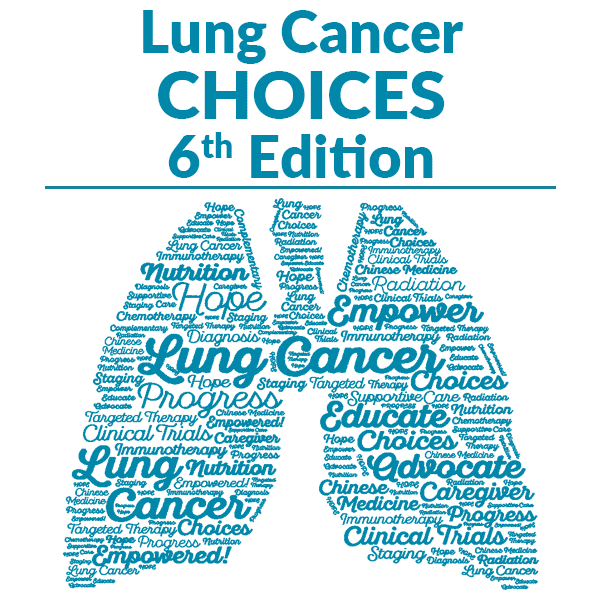Lung Cancer Choices© 6th Edition Menu
Chapter 1: Diagnosis and Staging of Lung Cancer
Chapter 2: Comprehensive Biomarker Testing
Chapter 3: Surgery for Lung Cancer Patients
Chapter 5: Radiation Therapy for Non-Small Cell Lung Cancer
Chapter 6: Treatment for Small Cell Lung Cancer
Chapter 7: Clinical Trials and Emerging Therapies for Lung Cancer
Chapter 9: Nutrition in the Patient with Lung Cancer
Chapter 10: Sexuality and Lung Cancer
Chapter 11: Integrative Medicine, Complementary Therapies, and Chinese Medicine in Lung Cancer
Chapter 12: Lung Cancer in People who have Never Smoked
Chapter 13: How to Quit Smoking Confidently and Successfully
Lung Cancer Question Builder - Develop your list of "Questions to Ask" your providers
Surgery for Lung Cancer Patients
Adam J. Bograd, MD, Maria Cattoni, MD, Lisa M. Brown, MD, MAS, Ben M. Hunt, MD, MSc, and Brian E. Louie, MD, MHA, MPH, FRCSC, FACS
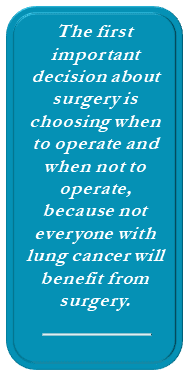 Introduction
Introduction
Surgery is one of the main options for treating patients who are diagnosed with lung cancer. Sometimes surgery is the only treatment necessary, and sometimes surgery is combined with chemotherapy or radiation therapy or both. It is not always easy to determine which treatment or combination of treatments may be necessary. Therefore, meeting with a surgeon who is specially trained in lung surgery is an important step in the management of lung cancer.
Many patients are nervous about the surgery, which is a normal, common reaction. We hope this chapter will prepare the patient and his or her support team for meeting with a surgeon and for surgery. This chapter has been divided into seven sections to address the following questions:
- When is surgery used to treat lung cancer?
- What types of surgery are used to treat lung cancer?
- How do I prepare for surgery?
- What can I expect on the day of surgery?
- What can I expect during the hospital stay?
- What is recovery like from lung surgery?
- Am I cured?
When Surgery is Used to Treat Lung Cancer
The first important decision about surgery is choosing when to operate and when not to operate, because not everyone with lung cancer will benefit from surgery. Furthermore, some people diagnosed with lung cancer may not be good candidates for surgery based on functional testing. There are two categories of lung cancer: small cell lung cancer (SCLC) and non-small cell lung cancer (NSCLC) (Figure 1). Surgery is not usually used to treat people with SCLC, although some exceptions exist. Most of this chapter will discuss NSCLC.
Surgery for Non-Small Cell Lung Cancer
NSCLC includes several different subtypes (Figure 1), but the treatment for all these subtypes is similar. After a person is diagnosed with NSCLC, the decision to proceed with the surgery is based on two factors: (1) the stage of cancer and (2) the ability of the patient to function without the cancerous portion of the lung. We will discuss these two factors in the next two sections of this chapter.
Figure 1: Lung Cancer, as seen through the microscope. A: Small cell carcinoma. B: Squamous cell carcinoma. C: Adenocarcinoma. D: Adenocarcinoma with lepidic features. B, C, and D are all different types of NSCLC.
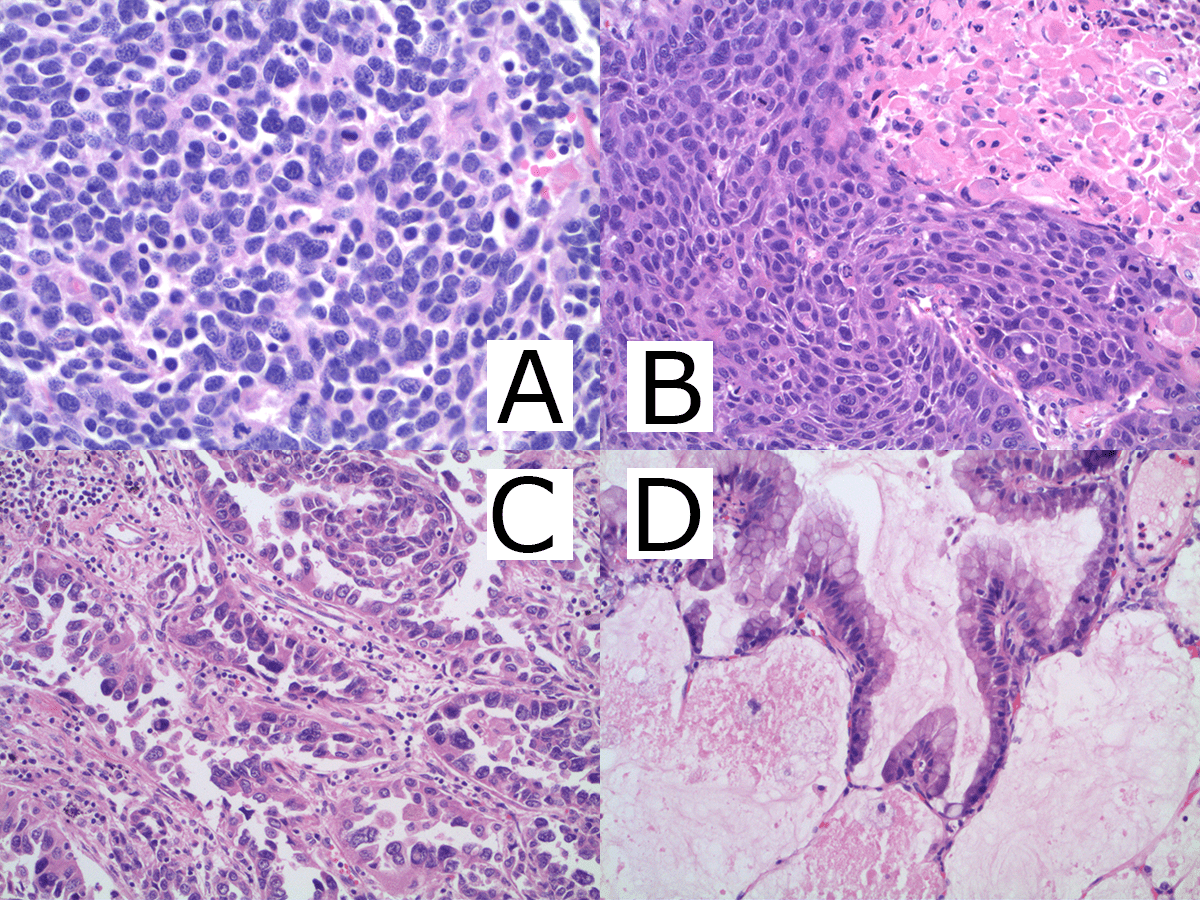
Image courtesy of Jey-Hsin Chen, MD, PhD
Lung Cancer Staging from the Surgeon’s Perspective
After a diagnosis of lung cancer has been made, the most important question is, “How far has it spread?” This process is called staging, more specifically, clinical staging. Staging is first determined by using imaging tests such as a positron emission tomography (PET) scan, a computed tomography (CT) scan, and often a brain MRI. From these tests, the surgeon can determine the location of cancer and assess whether cancer is confined to the lung or has spread to other areas in the body such as lymph nodes, the other lung, the brain, or other organs. These findings allow the surgeon to classify the cancer into one of four groups called “stage” (stage I, stage II, stage III, stage IV).
Usually, the combination of chest computed tomography scan (CT) and positron emission tomography (PET) are enough to determine the location and dimension of the lung cancer and whether it has already spread to other areas of the body such as the lymph nodes, the liver, the bones, and the adrenal glands. Generally, for stage IB and above, a Brain MRI (magnetic resonance imaging) will be obtained to make sure there has been no spread to the brain.
Determining the clinical stage of lung cancer helps the treating physicians determine the optimal treatment, as provided by organizations, the most common being the National Comprehensive Cancer Network (NCCN). In summary, lung cancer treatment is stage directed and specific.
Even though the PET, CT, and brain MRI are very good at detecting the spread of lung cancer to the liver, the bones, the adrenal glands, and the brain, there is an 8-10% chance of missing cancer in the lymph nodes in the center of the chest (Figure 2). Since determining the presence of cancer in the mediastinal lymph nodes is necessary to define the cancer stage, it is important to know more definitely whether cancer involves the mediastinal lymph nodes. Therefore, a biopsy (a small tissue sample) of the mediastinal lymph nodes is sometimes recommended before lung cancer surgery in certain instances. This is referred to as “mediastinal staging.”
Figure 2: The green-shaded area is the mediastinum. Purple dots around the airways are the mediastinal lymph nodes.
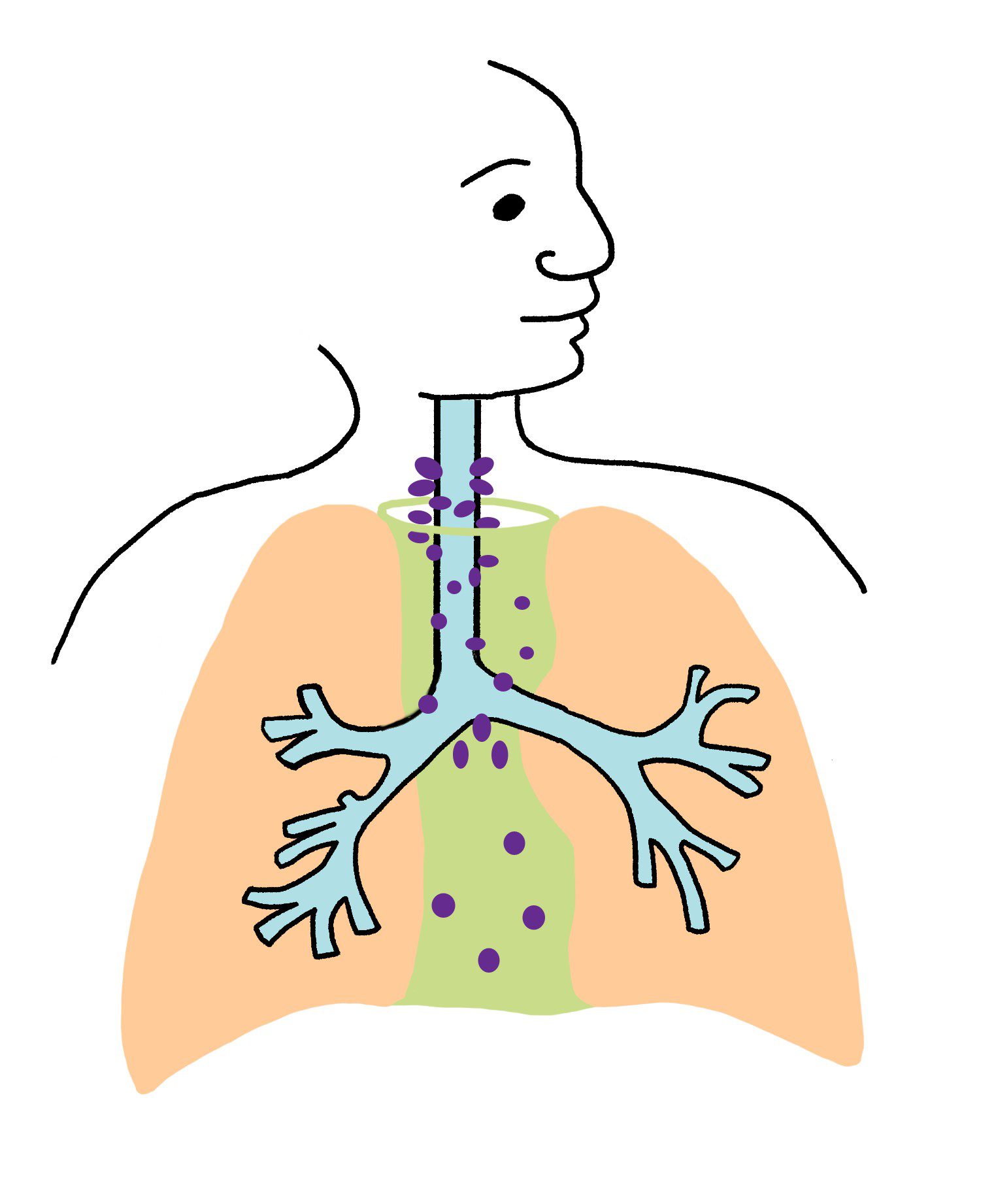
Illustration by Alexandra Hunt, MD
Mediastinal lymph nodes may be biopsied in several different ways. The two most common ways are (1) with a bronchoscope (a flexible camera that is inserted through the windpipe) and ultrasound imaging guiding a small needle into the lymph node or (2) an operation (mediastinoscopy). During a mediastinoscopy, a surgeon makes a small incision in the neck just above the breastbone and puts a camera behind the breastbone to take tissue samples of the mediastinal lymph nodes around the windpipe (Figure 3).
Figure 3: Mediastinoscopy: a scope and instruments are used to sample the mediastinal lymph nodes.
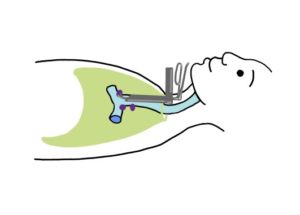
Illustration by Alexandra Hunt, MD
If the biopsy of the mediastinal lymph nodes shows no cancer, then we presume the patient to be in stage I or II and recommend surgical removal of the lung cancer as the initial treatment. However, if there are cancer cells in these lymph nodes, chemotherapy with or without radiation therapy is usually the first treatment, sometimes followed by surgery. This is referred to as induction or neo-adjuvant therapy.
The importance of defining the cancer stage is because lung cancer at different stages requires different treatments (Table 1). Surgery has a potentially curative role in NSCLCs that are stages I to III (Table 1) and in very select cases of stage IV lung cancer.
Table 1. Treatment of Lung Cancer by Stage1
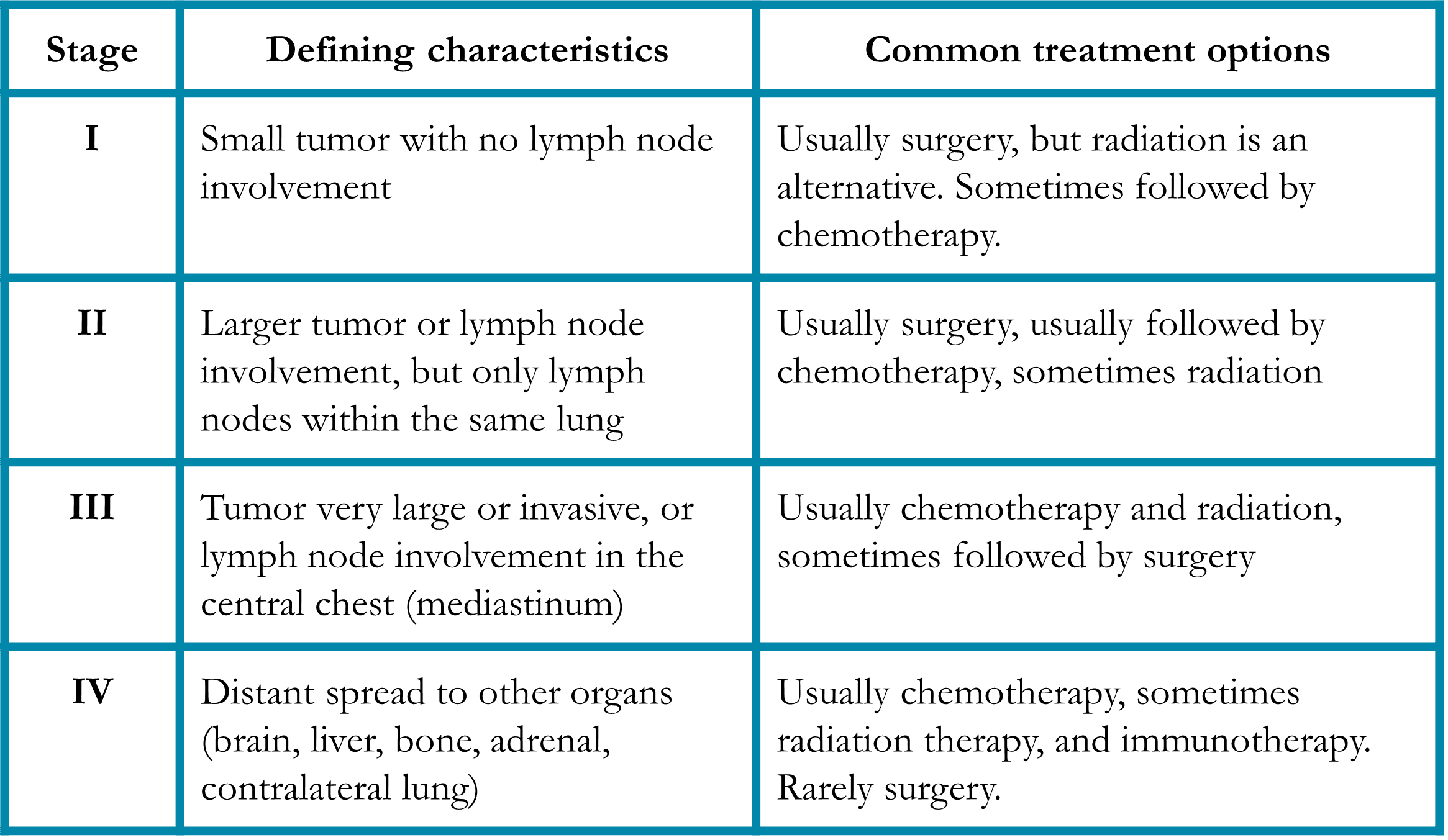
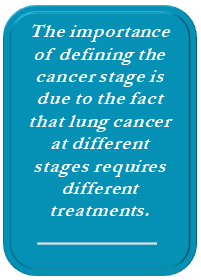 Surgery usually is the first step in the treatment of stage I and II NSCLCs. In stage III cancers, chemotherapy with or without radiation therapy is given first, and surgery follows if it will potentially be beneficial. One distinguishing feature (other than size of the tumor) between stages I, II, and III is the involvement of lymph nodes with cancer. In stage I, cancer has not spread to the lymph nodes. In stage II, the lymph nodes that are involved are located within the same lung being removed. In stage III, the lymph nodes involved are outside of the lung and organized around the main airway in the center of the chest, in the area of the body called the mediastinum (Figure 2). Stage IIIA lung cancer involves mediastinal lymph nodes on the same side of the chest as the primary lung cancer; surgery may be utilized in stage IIIA disease. Recently, immunotherapy has been utilized on a clinical trial basis, both pre- and post-op, in patients with more advanced stage lung cancer. Stage IIIB lung cancer denotes the spread of cancer to lymph nodes either on the opposite side of the chest or above the clavicles; surgery is typically not an option for stage IIIB lung cancer, with a few, limited exceptions. When cancer has spread to the lymph nodes in the mediastinum, surgery alone is not appropriate. In this case, studies have shown that chemotherapy with or without radiation therapy, sometimes combined with surgery, has a better outcome than surgery alone.
Surgery usually is the first step in the treatment of stage I and II NSCLCs. In stage III cancers, chemotherapy with or without radiation therapy is given first, and surgery follows if it will potentially be beneficial. One distinguishing feature (other than size of the tumor) between stages I, II, and III is the involvement of lymph nodes with cancer. In stage I, cancer has not spread to the lymph nodes. In stage II, the lymph nodes that are involved are located within the same lung being removed. In stage III, the lymph nodes involved are outside of the lung and organized around the main airway in the center of the chest, in the area of the body called the mediastinum (Figure 2). Stage IIIA lung cancer involves mediastinal lymph nodes on the same side of the chest as the primary lung cancer; surgery may be utilized in stage IIIA disease. Recently, immunotherapy has been utilized on a clinical trial basis, both pre- and post-op, in patients with more advanced stage lung cancer. Stage IIIB lung cancer denotes the spread of cancer to lymph nodes either on the opposite side of the chest or above the clavicles; surgery is typically not an option for stage IIIB lung cancer, with a few, limited exceptions. When cancer has spread to the lymph nodes in the mediastinum, surgery alone is not appropriate. In this case, studies have shown that chemotherapy with or without radiation therapy, sometimes combined with surgery, has a better outcome than surgery alone.
Surgery in Stage IV Cancer
If cancer has spread to distant sites, it may not be possible or beneficial to remove all cancer with surgery. Additionally, if cancer invades structures that cannot be removed (for example, the heart), then surgery may not be appropriate as primary treatment. However, there can be a role for surgery in widespread cancer if surgery will help relieve some of the symptoms caused by cancer. If the tumor is blocking an airway, a limited procedure might be done to unplug the airway. When advanced cancer blocks the lymph channels draining the space around the lung, fluid can build up in this space. Surgery may be required to drain this space and re-expand the lung to relieve the symptoms associated with the fluid. However, most surgery for lung cancer is done for limited disease (lower stages), usually with the goal of curing cancer. Occasionally, stage IV cancer has spread to only a single location outside of the lung, such as the brain or adrenal gland, and may be a candidate for surgical treatment of both the metastasis (the single cancer location outside of the lung) and the primary lung cancer. This is referred to as “oligometastatic disease.” This special situation should be discussed with the cancer team (the surgeon, the oncologist and the radiation oncologist). Certain targeted therapies and immunotherapies are also being increasingly utilized in advanced stage lung cancer. However, specific testing of the tumor for certain “markers” is required to see if the tumor qualifies for treatment with these modalities.
Preoperative Testing
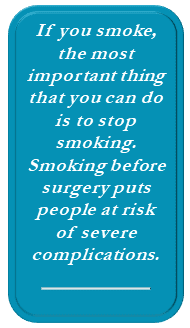 Even if lung cancer can be removed based on the results of the staging tests, not every person can have part of their lung removed and return safely to their normal life outside the hospital. Every operation has risks, and one of the difficult aspects of surgery is choosing which people will do well after surgery and which people will have difficulty recovering from surgery. Surgeons use many different tests to help predict which patient can undergo surgery safely and be able to live with less of the lung after surgery.
Even if lung cancer can be removed based on the results of the staging tests, not every person can have part of their lung removed and return safely to their normal life outside the hospital. Every operation has risks, and one of the difficult aspects of surgery is choosing which people will do well after surgery and which people will have difficulty recovering from surgery. Surgeons use many different tests to help predict which patient can undergo surgery safely and be able to live with less of the lung after surgery.
The most important test we use to decide when to operate is the simplest: a thorough history and physical examination. The surgeon asks questions about the patient’s current state of health and past medical history and performs a physical exam to make sure the patient is prepared for the operation.
Problem areas that come up during the history and physical examination may be evaluated with more testing. There are two major issues to consider preoperatively: to make sure that the patient is healthy enough to safely have surgery, and to find any other health problems that can be improved before the operation. For example, diabetes should be well controlled before surgery since it impacts wound healing. It is also very important to stop smoking before lung surgery in order to reduce the risk of respiratory complications after surgery. See Chapter 13: How to Quit Smoking Confidently and Successfully. After dealing with each person’s health problems, the preoperative workup for lung surgery focuses on the lungs and the heart in order to evaluate the performance of these two organs.
Lung and Heart Function
Surgery for lung cancer usually involves removing part of a person’s lung. Therefore, it is important to be sure that the person will be left with enough functioning lung after surgery to provide oxygen to, and eliminate carbon dioxide from, the body. A simple test such as climbing stairs or walking as far as possible in six minutes may be used to give an overall idea of heart and lung fitness, but more detailed testing usually is required before lung surgery.
The tests most commonly used to evaluate the lungs before surgery are called pulmonary function tests. These tests check the lung volumes, air flows, and gas exchange capabilities. They give a baseline measure of lung function and help predict whether the lungs will be able to do their job adequately after part of the lung is removed during surgery. The tests are designed to measure how much air can be moved in and out of the lungs, and how quickly gases diffuse from the lungs into the blood. The tests involve breathing through a machine that measures the airflow and inhaling a marker gas (a very small amount of carbon monoxide) to test how quickly that gas is removed from the air in the lungs. It is important to stop smoking before the pulmonary function test because blood levels of carbon monoxide are elevated after smoking, and this can interfere with the test. Medication may be given during the test to determine whether lung function can be improved with medication.
If a person’s pulmonary function tests show limited lung function, then a quantitative ventilation/ perfusion scan (QV/Q scan) is used to determine how much air and blood flow goes to each section of the lung. This allows the surgeon to calculate how much lung function will remain after the section of the lung containing the cancer is removed, thus predicting how the person will respond to surgery. If concerns remain after the QV/Q test, the patient may be asked to have other tests, including exercise tests and blood tests. The purpose of all the lung function tests is to predict whether there will be enough lung function remaining to allow the patient to return to normal life after surgical removal of the part of the lung with cancer.
Often it is also necessary to evaluate the patient’s heart before lung surgery because the risk factors for heart disease are often present in patients who develop lung cancer. Furthermore, surgery places the body under stress. The body mobilizes every resource available to heal after surgery, and this effort can place major stress on the heart, especially when an entire lung has been removed (pneumonectomy). Therefore, it is important to check that the heart is functioning adequately before performing an operation. In some cases, a history and physical examination can provide enough information to reassure the treatment team that the heart will be able to safely power the body through the stress of surgery. If further testing is required, it may be simply an electrocardiogram (ECG). Another test that might help predict how the heart will respond to the stress of surgery is a stress test, in which stress is placed on the heart by walking on a treadmill or by injecting a medication that stresses the heart. Imaging of the heart may include an ultrasound test (echocardiogram) or a scan (myocardial perfusion study). If any problems with the heart are found during testing, additional procedures (such as cardiac catheterization) or medicines may be required to make sure the heart is as ready as possible before surgery.
Alternatives to Surgery
If surgery is not recommended after the staging workup and heart and lung testing, there are several alternative treatments available. These treatments also may be used before or after surgery, to give the best chance that cancer will not spread to other parts of the body or recur in the lungs after treatment. Radiation therapy can be used to kill cancer cells in a particular part of the body. The radiation is focused at the known or suspected location of the cancer. New highly-focused radiation techniques allow maximum doses of radiation to be delivered precisely to cancer, killing cancer while sparing as much normal tissue as possible. In some people with stage I or II cancers with poor lung function, focused radiation may be recommended instead of surgery. Chemotherapy medicines, given either intravenously or as pills, kill cancer cells throughout the body. Chemotherapy medicines spread through the entire body, and they can kill cancer cells that haven’t been discovered or are too small to show up on imaging.
Surgery for Small Cell Lung Cancer
SCLC is very different from NSCLC. SCLC tends to spread more quickly than NSCLC, and surgery alone has a minimal chance of curing SCLC, even in the early stages. Chemotherapy and radiation are the primary treatments for most SCLCs. However, surgery may benefit a small group of patients with early SCLC, used in combination with chemotherapy, with or without radiation therapy. Surgery for SCLC is reserved for patients with small lung tumors and no evidence of spreading to the lymph nodes. Therefore, a surgical sampling of the lymph nodes from the middle of the chest is also part of the staging workup of SCLC if surgery is contemplated. See Chapter 1: Diagnosis and Staging of Lung Cancer and Chapter 6: Treatment for Small Cell Lung Cancer.
Types of Surgery to Treat Lung Cancer
Various approaches may be used to remove lung cancer. The most common approach is an incision between the ribs to access the lung and surrounding lymph nodes (Figure 4a). This incision (a thoracotomy) wraps around the side of the chest, parallel with the ribs, and allows the surgeon direct access to the lungs and the other contents of the chest.
Figure 4a: Thoracotomy: the blue line corresponds to the chest incision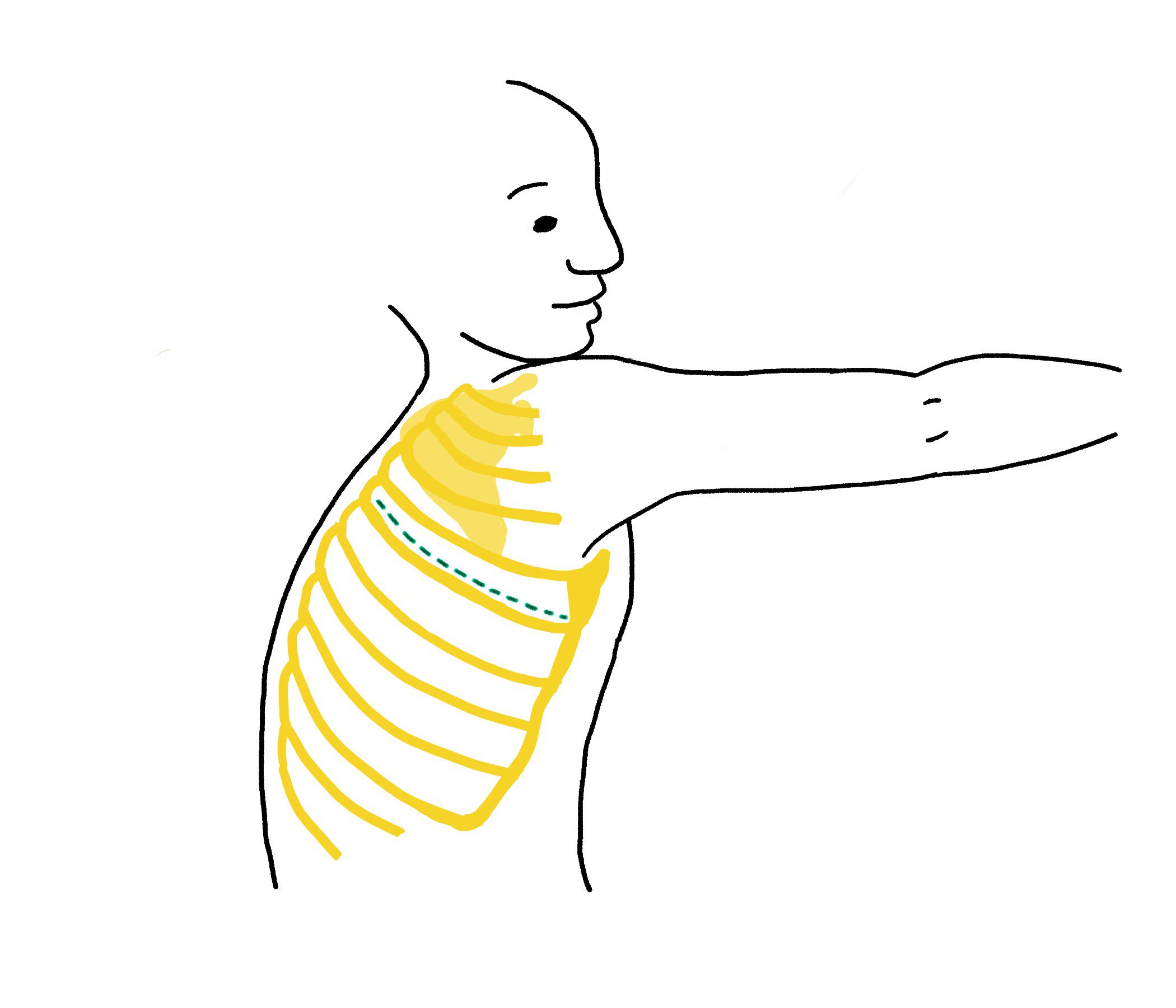
Illustration by Alexandra Hunt, MD
To limit the pain and shorten the recovery after surgery, sometimes it is possible to do surgery without performing a full thoracotomy. One way to do this is to use a video camera that goes into the chest through a small incision, combined with instruments that enter the chest through other small incisions. This type of surgery is called video-assisted thoracic surgery (VATS) (Figure 4b). A further refinement of VATS is to mount the instruments to a robot (Figure 4c), which allows very precise control when manipulating the lung and delicate surrounding tissues. However, it is important to be aware that even if the surgeon plans to do the operation using the VATS approach or the robot, sometimes it is necessary to convert during the operation to a bigger incision (thoracotomy). Most patients with early stage lung cancers should have their resection with a minimally invasive technique, either VATS or robotic.
Figure 4b: Video-Assisted Thoracic Surgery (VATS) and robotic thoracic surgery incisions: the blue lines correspond to the chest incisions.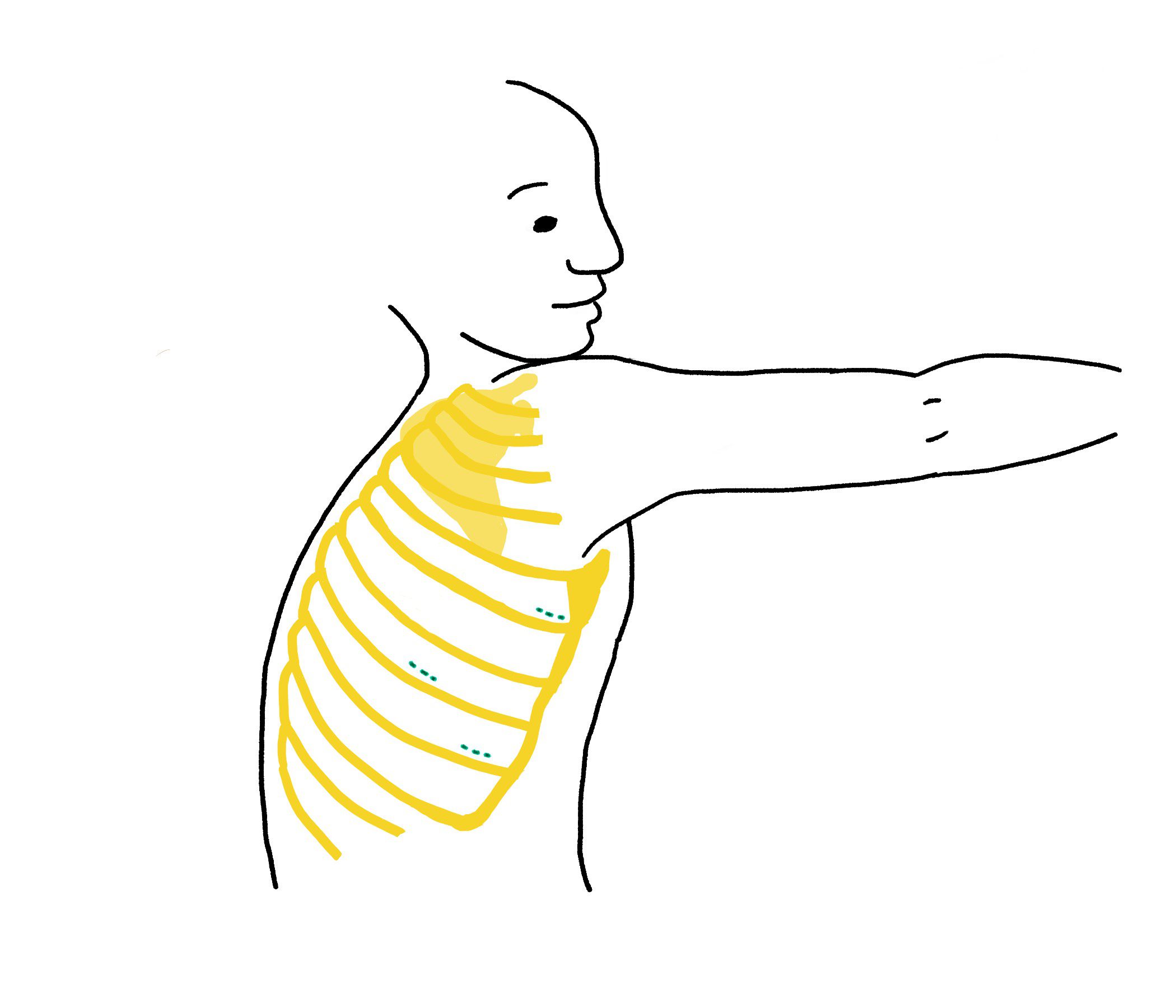 Illustration by Alexandra Hunt, MD
Illustration by Alexandra Hunt, MD
Figure 4c: Robotic thoracic surgery Illustration by Alexandra Hunt, MD
Illustration by Alexandra Hunt, MD
Besides deciding which approach will be used to remove the portion of the lung containing cancer, a surgeon must decide exactly what to remove. The priority is to remove cancer. It is important to remove some normal surrounding lung along with the cancer because there are microscopic extensions of cancer that can grow and cause cancer recurrence if they are not removed. The most common surgery for lung cancer removes the entire lobe containing cancer, together with the lymph nodes inside the lobe (lobectomy) (Figure 5a). Removing the entire lobe allows the best possibility for long term survival and remains the gold-standard.2 However, recent studies have been evaluating whether the resection of the cancer within a smaller part of the lung (segmentectomy) has the same results, in term of survival and probability of cancer recurrence that occurs when removing the entire lobe (lobectomy). The results of these studies will be available in the next years. In patients with adequate pulmonary function, a sublobar resection (either a wedge or segmentectomy) should be reserved for early-stage (<2cm) or slow-growing subtypes (i.e., carcinoid) or lung cancer.
In patients where there will not be enough healthy lung left after an entire lobe is removed, the surgeon may decide to remove just the tumor with a small amount of surround lung, termed a “sub-lobar resection.” This may consist of either a wedge resection or a segmentectomy that contains cancer (Figure 5b). If the tumor is too close to the center of the chest, or if the main airways of the lung are involved, sometimes it may be necessary to remove the entire lung that is affected by cancer (pneumonectomy) (Figure 5c). Airways may be divided and sewn back together (“sleeve resection”), if this allows complete removal of cancer without removing as much healthy lung tissue (Figure 5d). In addition to removing the part of the lung that is affected by cancer, lung cancer surgeons remove lymph nodes in the chest at the time of lung surgery, to evaluate whether cancer has spread to these lymph nodes.
Figures 5a-d: Types of Resection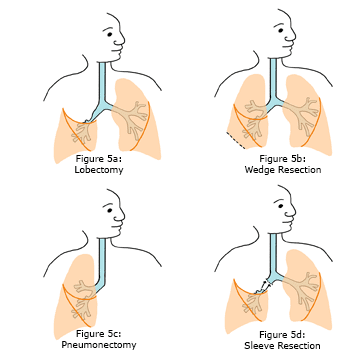
Illustration by Alexandra Hunt, MD
How do I Prepare for Surgery?
Deciding to proceed with surgery can be intimidating because many aspects of surgery are beyond the patient’s control, and this loss of control can be frightening. However, there are many factors about the surgery that the patient can control. In this section, we will discuss a few things that the patient can do to make their operation go more smoothly.
If you are a current smoker, preoperatively, the most important thing that a person can do is to stop smoking if they have not done so already. Smoking before surgery puts people at risk of severe complications (Table 2).
Table 2. Risks of Smoking at the Time of Surgery3,4

Smoking paralyzes the tiny hairs called cilia that clear secretion out of the airways. Keeping the lungs clean after surgery is an important way to prevent complications after surgery, such as infections and inadequate lung function. Stopping smoking at least 4-6 weeks before surgery and remaining smoke-free after surgery may reduce your risk of post-operative complications by 50% in some studies. Quitting smoking is a simple step that can dramatically improve the chances that surgery will go well, but quitting can be very difficult to do. There are many resources available to help people quit smoking, and the chance of being able to quit successfully is much better if these resources are used.5 Even if a smoker cannot quit long term, they can improve their outcome after surgery if they are able to stop smoking before surgery (ideally at least 6-8 weeks before surgery7 ) and stay off cigarettes until they have successfully healed from surgery.6-8 See Chapter 13: How to Quit Smoking Confidently and Successfully.
 Besides quitting smoking, there are several other things that a person who is anticipating surgery can do to take some control over their surgical course proactively. The surgery will stress the patient’s body, so it is important to prepare as much as possible beforehand. Exercise, proper nutrition, and vitamins (including antioxidants) can help prevent complications from surgery. Even if there are only one or two weeks between the diagnosis and the scheduled date of surgery, every day helps. Making the body as healthy as possible before surgery is a good way to be an active participant in the fight against cancer.
Besides quitting smoking, there are several other things that a person who is anticipating surgery can do to take some control over their surgical course proactively. The surgery will stress the patient’s body, so it is important to prepare as much as possible beforehand. Exercise, proper nutrition, and vitamins (including antioxidants) can help prevent complications from surgery. Even if there are only one or two weeks between the diagnosis and the scheduled date of surgery, every day helps. Making the body as healthy as possible before surgery is a good way to be an active participant in the fight against cancer.
A daily exercise routine can improve the fitness of the heart and lungs and prepare the body for the stress of surgery. It is important to get approval from your doctor before starting an exercise regimen. Certain institutions have intensive exercise “pre-habilitation” programs that may be used pre-operatively for some patients; patients should ask their physicians if they would benefit from such programs. Proper nutrition, including a high protein diet, can build up the body’s store of building blocks to use during recovery after the operation.9 Vitamins and antioxidants can be important to help fight off infections and rebuild tissues after surgery.10
What Can I Expect on the Day of Surgery?
The day of surgery can be frightening because most people do not know what surgery will be like. This section will describe what to expect on the day of surgery, so there are fewer unknowns and fewer surprises.
Your surgeon should give you specific instructions regarding how to prepare for your day of surgery. It is important to arrive at the hospital in plenty of time before the scheduled surgery, to make sure that there is enough time to get ready. Generally, one should aim to arrive at least 2 hours before surgery unless otherwise instructed. Be sure to bring your identification, insurance card, and other items you may need to make your hospital stay more comfortable (loose-fitting clothing, slippers, personal hygiene items). Try to refrain from bringing valuables to the hospital. All jewelry should be removed, as it has the potential to impact some of the instruments used in surgery.
After the patient arrives at the hospital, he or she is registered into the hospital system and receives an identifying band to remind all the hospital staff of his or her correct identity, which will be checked repeatedly to make sure that the correct procedures are performed on the correct patient. An intravenous line usually is started for medications. Various tests may be performed, such as blood tests, to make sure that there are no surprises during the operation. A repeat electrocardiogram may be performed in some cases. Many of the same questions will be asked to recheck the correct information about the patient, such as allergies to medications.
 The patient may be asked to stop certain medications before surgery. This is especially important with some blood pressure medications and medications that interfere with blood clotting such as aspirin, warfarin, and clopidogrel. Blood thinners have different rates in which they clear the body, so it is important to find out exactly how many days prior to surgery they need to be stopped. Surgery may be canceled if these blood thinners are not stopped in time. Supplements and naturopathic formulations should be noted on the medication list. Fish oil, omega-3 supplements, Ginkgo biloba, and vitamin E can slow blood clotting and should be discussed with the surgeon. To decrease the possibility of vomiting during anesthesia or sedation, it is important to not eat or drink anything before the procedure. Your doctor will give specific guidelines, but the usual rule is that there should be no food or drink consumed after midnight before surgery. Morning medications usually may be taken with a sip of water, but one should check with their surgeon regarding which medications to take and if it is allowable to take them with a sip of water the morning of surgery. Often there is input regarding this from the anesthesia team, so asking these questions well ahead of time may alleviate issues.
The patient may be asked to stop certain medications before surgery. This is especially important with some blood pressure medications and medications that interfere with blood clotting such as aspirin, warfarin, and clopidogrel. Blood thinners have different rates in which they clear the body, so it is important to find out exactly how many days prior to surgery they need to be stopped. Surgery may be canceled if these blood thinners are not stopped in time. Supplements and naturopathic formulations should be noted on the medication list. Fish oil, omega-3 supplements, Ginkgo biloba, and vitamin E can slow blood clotting and should be discussed with the surgeon. To decrease the possibility of vomiting during anesthesia or sedation, it is important to not eat or drink anything before the procedure. Your doctor will give specific guidelines, but the usual rule is that there should be no food or drink consumed after midnight before surgery. Morning medications usually may be taken with a sip of water, but one should check with their surgeon regarding which medications to take and if it is allowable to take them with a sip of water the morning of surgery. Often there is input regarding this from the anesthesia team, so asking these questions well ahead of time may alleviate issues.
The night before surgery and again the morning of surgery, you will be asked to use antibacterial soap. This soap is most commonly chlorhexidine based.
The patient will meet many new people the day of surgery; however each one of these people is here to ensure that your surgery is performed safely and efficiently. There will be an operating room nurse who is in charge of making sure that the operating room works properly. In the operating room, the scrub technologist oversees making sure that the surgeon has the equipment he or she needs and keeping the surgical field sterile. The surgeon usually will have an assistant. There will be a doctor or a specialized nurse who will give anesthesia. The anesthetist may talk to the patient about placing an epidural catheter, which is a way of delivering pain medication directly to the fibers in the spinal cord that conduct pain signals to the brain.
Occasionally, the patient will be given anti-anxiety medication before going to the operating room. In the operating room, the patient will be asked to move onto the operating room bed. This bed is quite narrow so that the surgeon can easily reach the patient. The patient will be covered in warm blankets because it is important to maintain the body’s usual temperature during the operation to help prevent the patient from getting complications. General anesthesia, in which the patient is completely asleep, is required for most lung operations. After the patient is asleep, the anesthetist places a breathing tube through the mouth into the windpipe. This tube sometimes causes a sore throat after surgery. The patient is positioned on the operating room bed, the skin is scrubbed with an antibacterial scrub, and the patient is covered in sterile drapes. A safety pause is performed to confirm that the correct surgery is being performed on the correct patient and the correct side.
The surgeon makes a skin incision, either a small one for the video camera or a larger incision for open surgery. The tissues of the chest wall are moved out of the way, and an opening is made between the ribs large enough to perform the procedure. After the surgeon can see inside the chest, the first step of the procedure is a careful inspection to make sure that cancer has not spread further than the preoperative workup indicated and to look for anything unexpected. If the inspection does not reveal any reason to stop the operation, the surgeon then mobilizes the lung so that it can be moved around more easily into the field of view. Mobilization involves dividing bands of scar tissue and ligaments that hold the lung in place in the chest cavity. After the lung can move freely, the surgeon carefully dissects the lung containing cancer away from the rest of the body. Specially designed staplers that seal tissue while it is being cut are used to assist with the dissection. The surgeon is always quite careful not to spill cancer into the chest cavity to minimize the possibility that cancer will spread after surgery.
The specimen is removed from the body and given to the pathologist, who carefully cuts the specimen into thin slices, stains the slices, and examines them using a microscope. The pathologist confirms the type of cancer and assesses how large it is, where it is in relation to the cut edges of the lung and the underlying tissues, and whether lymph nodes are involved. Just like the cancer was staged with imaging and an examination before surgery, the pathologist stages cancer based on the resected specimen. This is known as the pathologic stage and will guide the surgeon as to if more therapy (chemotherapy, radiation, or further surgery) post-operatively is required. A formal pathology report usually takes 5-7 days to complete. The pathologist is sometimes asked to tell the surgeon whether the cut edges are free of cancer; this is done immediately in the operating room with a “frozen section.” If not, more tissue may be taken to get a clean margin. After the cancer has been removed, the surgeon examines the remaining healthy tissues to make sure that all bleeding has stopped, that the remaining lung inflates well and that no air is leaking out of the remaining healthy lung. After the surgeon is satisfied, he or she usually places a drain to evacuate air and fluid out of the space between the chest wall and the lung (the pleural space). The lung naturally falls away from the chest wall and collapses on itself, but the drain can help hold the lung up against the chest wall. This drain (called chest drain or chest tube) stays in place until the lung is sealed, and there is no drainage, which is usually 1-3 days after surgery. Finally, the surgeon closes the incision and applies sterile dressings. After the procedure is complete, the patient wakes up in the recovery room. Most people are not aware that any time has passed between when anesthesia was started and when they wake up in the recovery room.
Most people stay in the recovery room for a few hours while the anesthesia wears off. There are nurses in the recovery room who carefully monitor patients to make sure that everything is going well after surgery. A chest radiograph usually is done in the recovery room to recheck that the lung has completely re-expanded after surgery and that the tubes and drains are in the correct locations. After the patient is awake enough to leave the recovery room, he or she is brought to a bed in the hospital to continue recovery.
What Can I Expect During the Hospital Stay?
Hospital care after major lung surgery is very important for a full recovery. After surgery is one of the most important times for a lung cancer patient to play an active role in his or her care. The more a person can clean out and re-expand their lungs after surgery, the smaller the possibility of getting an infection in the collapsed lung or space around the lung. For this reason, the surgical team, the nurses, and the physical and respiratory therapists will repeatedly be reminding the patient to cough, take deep breaths, and get out of bed to move around. Staying active after surgery helps the lungs re-expand completely, and helps prevent many different types of complications.11 Your care team will assist you in the use of an “incentive spirometer.” This is a small device that will improve your ability to take a deep breath and strengthen your respiratory muscles. You will be asked to use this multiple times per hour, every hour you are awake.
Being active after surgery can be difficult because chest surgery can be quite painful. However, there are many ways to control pain after surgery, and the hospital team may select a variety of approaches to deal with the pain from the surgery. One of those is placing a small tube, called epidural catheter, alongside the spinal column just outside the membranes that surround the spinal cord. This tube allows a continuous dose of medication to be delivered to the nerves in the spinal cord that transmit pain signals to the brain to control the pain. A well placed epidural catheter is one of the most effective ways to manage pain after chest surgery.12
Local anesthetics are medications that block the transmission of pain signals along nerve fibers. They may be used in an epidural catheter, or they may be used to directly block the nerves that supply the chest wall, either during or after surgery. Narcotics (also known as opiates) are another class of medications that help control pain after major surgery. They block pain receptors in the brain, spinal cord, and other tissues. Narcotics may be given through an epidural catheter, intravenously (either by a nurse, or with a machine that gives a dose every time a button is pressed), or by mouth. Narcotics can have several unpleasant side effects, such as constipation, confusion, decrease in the drive to breathe, and itching. Many other types of medicines may be used to help control pain and to limit the number of narcotics needed. Pain control is important to keep the patient comfortable and allow the patient to move around, cough, and do breathing exercises to prevent complications after surgery.
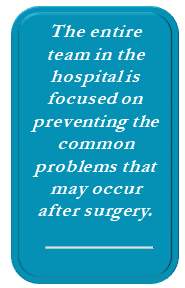 The entire team in the hospital is focused on preventing the common problems that may occur after surgery. This is the reason that they gather so much data about each patient. Nurses and nurse’s aides check vital signs (including the pain level) several times each day to identify any potential problem early in the course of its development. Radiographs may be taken at several different times during the hospital stay, to make sure that the lung stays fully expanded and that no space develops between the lung and the chest wall. If a chest drain is in place, it is carefully inspected, and the amount of fluid coming out of the drain is recorded. Chest drains are typically left in place until drainage is under a certain threshold, and leakage of air has stopped. Most surgeons err on the side of caution with removing chest drains as they are sometimes difficult to reinsert if removed too early. Every medication that has been given is documented. All this documentation is focused on making sure that the patient continues to get better all the time, and that any complications that develop are found early.
The entire team in the hospital is focused on preventing the common problems that may occur after surgery. This is the reason that they gather so much data about each patient. Nurses and nurse’s aides check vital signs (including the pain level) several times each day to identify any potential problem early in the course of its development. Radiographs may be taken at several different times during the hospital stay, to make sure that the lung stays fully expanded and that no space develops between the lung and the chest wall. If a chest drain is in place, it is carefully inspected, and the amount of fluid coming out of the drain is recorded. Chest drains are typically left in place until drainage is under a certain threshold, and leakage of air has stopped. Most surgeons err on the side of caution with removing chest drains as they are sometimes difficult to reinsert if removed too early. Every medication that has been given is documented. All this documentation is focused on making sure that the patient continues to get better all the time, and that any complications that develop are found early.
Despite careful monitoring, complications may occur after surgery. Percentages cited in parentheses are from a large series of lung surgery patients studied at several different hospitals.13 Air leaks are common after lung surgery (8% persist for > 7 days). They happen when the air in the lung leaks into the pleural space (which is the space between the lung and the chest wall). The body is usually able to seal the leak on its own, but large leaks may require repeat surgery. In certain instances of small persistent leaks, patients may be asked to go home with a chest drain in place temporarily.
Heart problems are common after lung surgery because many people with lung cancer have heart disease, and chest surgery can disturb the heart’s normal rhythm. Irregular heart rhythms such as atrial fibrillation occur (14%) after surgery, and heart attacks can occur in the postoperative period (< 1%). The body swells and retains fluid in response to injury, and this fluid may take some time to clear after surgery. Infections are a potential complication of any surgery. Pneumonia (3%) and infection of the pleural space (1%) are the most common infections after lung surgery. There is a risk of bleeding after any surgery, but the risk of serious bleeding during or after lung surgery is low (2% need a blood transfusion, 1% to 2% need reoperation).
Finally, there is a risk that the person with lung cancer cannot function effectively on the amount of lung remaining after the tumor is removed. This is called respiratory failure (5%) and may result in the need for a mechanical ventilator for a short time after surgery, which is a machine that breathes for patients in the Intensive Care Unit (ICU). Some patients with respiratory failure may need portable supplemental oxygen to breathe at home.
What is Recovery from Lung Cancer Surgery Like?
Recovery does not stop after discharge from the hospital, and problems may occur after the patient returns home. It is important to continue to exercise on a regular basis after coming home from surgery. Keep the lungs clean with lung exercises such as coughing and deep breathing. Pain does not stop after leaving the hospital, and a combination of pain medications may be needed to keep pain at a tolerable level. Narcotic pain medications cause constipation, so it is important to make sure that people who are taking narcotics continue to have regular bowel movements. Stool softeners, fiber, choosing a healthy diet, and an active life can help keep the bowels moving.
After lung surgery, lung function usually slowly improves with time, as the remaining lung heals and starts to compensate for the lung that was taken out during surgery. Many people need oxygen for a short time after surgery, and some people are discharged from the hospital with portable oxygen for home use. Oxygen requirements usually decrease with time, and most people that were not on home oxygen before surgery do not require long term oxygen treatment after surgery. The scars also slowly remodel with time and become less noticeable.
The surgeon will want to continue to see the patient in the clinic to make sure that the recovery from surgery continues to progress, to answer any questions that may arise, and to put a plan in place for dealing with cancer in the future. This plan usually involves periodic imaging and checkups to make sure cancer does not recur. Chemotherapy, radiation, and other treatments may be recommended in addition to surgery according to the final results obtained by the pathologist after analyzing the cancer, the lung and the lymph nodes resected during the surgery. This determines the final stage of cancer more accurately than the preoperative tests and is more determinant of 5-year overall survival than the clinical stage.
Am I Cured?
 The goal of most cancer surgery is to cure cancer permanently. After the patient has recovered from surgery, the surgeon and other members of the cancer team will discuss the results of surgery and the final analysis by the pathologist with the patient. Patients who are eligible for surgical treatment usually have earlier stage cancers, so they are more likely to have long-term survival and cure. However, the long-term prognosis after lung cancer surgery is highly variable and depends on the available treatments and the final pathologic stage of cancer. The details of the pathology report, namely the size and characteristics of the primary tumor (T-stage), as well as if there is cancer in the lymph nodes (N-stage), will be used to decide if post-operative chemotherapy and/or radiation is needed. Furthermore, molecular testing of tumor cells is becoming increasingly more common as data emerges regarding the use of targeted and immune therapies in the post-operative setting. See Chapter 2: Comprehensive Biomarker Testing in Lung Cancer.
The goal of most cancer surgery is to cure cancer permanently. After the patient has recovered from surgery, the surgeon and other members of the cancer team will discuss the results of surgery and the final analysis by the pathologist with the patient. Patients who are eligible for surgical treatment usually have earlier stage cancers, so they are more likely to have long-term survival and cure. However, the long-term prognosis after lung cancer surgery is highly variable and depends on the available treatments and the final pathologic stage of cancer. The details of the pathology report, namely the size and characteristics of the primary tumor (T-stage), as well as if there is cancer in the lymph nodes (N-stage), will be used to decide if post-operative chemotherapy and/or radiation is needed. Furthermore, molecular testing of tumor cells is becoming increasingly more common as data emerges regarding the use of targeted and immune therapies in the post-operative setting. See Chapter 2: Comprehensive Biomarker Testing in Lung Cancer.
With modern surgery, possibly accompanied by chemotherapy and radiation, it is common for people with early-stage lung cancer to be completely cured (Table 3).
Table 3. The Percentage of Patients with Non-small Cell Lung Cancer who are Alive Five Years After Diagnosis14-15

For physicians, cure or survival is measured at the five-year mark. Although many people may return to their normal lives after surgery, people often wonder if cancer will return. The longer people live after completing their treatment, the smaller the risk they have of having cancer recur. Five years after treatment is completed, we consider a patient to be cured, and we celebrate this landmark with all of our patients who reach it. However, during these five- years, it’s important to follow a surveillance program to detect early cancer recurrence or new lung cancer. This program that is generally proposed by the surgeon and consists of both periodical physical examination and imaging tests should be completed by the patient.
Conclusion
 Lung cancer is a frightening diagnosis, but treatments have markedly improved in recent years. Surgery to remove the lung that contains the cancer is the mainstay of treatment in early stage NSCLC. Successful surgery is a partnership between the surgeon and the patient. The surgeon will thoroughly evaluate the patient with lung cancer to determine if surgery is the best option. The patient should actively participate in his or her care by stopping smoking, remaining active or becoming more active, and eating a healthy diet. The patient and the surgeon need to work together to make sure that the surgical and non-surgical care of lung cancer gives the best potential for the long-term cure of cancer and a quick return to normal life.
Lung cancer is a frightening diagnosis, but treatments have markedly improved in recent years. Surgery to remove the lung that contains the cancer is the mainstay of treatment in early stage NSCLC. Successful surgery is a partnership between the surgeon and the patient. The surgeon will thoroughly evaluate the patient with lung cancer to determine if surgery is the best option. The patient should actively participate in his or her care by stopping smoking, remaining active or becoming more active, and eating a healthy diet. The patient and the surgeon need to work together to make sure that the surgical and non-surgical care of lung cancer gives the best potential for the long-term cure of cancer and a quick return to normal life.

Questions to Ask Your Treatment Team
References
- Goldstraw P, Crowley J, Chansky K, et al. The IASLC Lung Cancer Staging Project: proposals for the revision of the TNM stage groupings in the forthcoming (seventh) edition of the TNM Classification of malignant tumours. J Thorac Oncol. 2007;2(8):706-14.
- Ginsberg RJ, Rubinstein LV. Randomized trial of lobectomy versus limited resection for T1 N0 non-small cell lung cancer. Ann Thorac Surg. 1995;60(3):615-623.
- Barrera R, Shi W, Amar D, et al. Smoking and timing of cessation: impact on pulmonary complications after thoracotomy. 2005;127:1977-83.
- Møller AM, Villebro N, Pedersen T, et al. Effect of preoperative smoking intervention on postoperative complications: a randomised clinical trial. 2002;359(9301):114-7.
- Browning KK, Ahijevych KL, Ross P, et al. Implementing the Agency for Health Care Policy and Research’s Smoking Cessation Guideline in a lung cancer surgery clinic. Oncol Nurs Forum. 2000;27(8):1248-54.
- Shi Y, Warner DO. Surgery as a teachable moment for smoking cessation. 2010;112(1):102
- Warner MA, Offord KP, Warner ME, et al. Role of preoperative cessation of smoking and other factors in postoperative pulmonary complications: a blinded prospective study of coronary artery bypass patients. Mayo Clin Proc. 1989;64(6):609–16.
- Lindström D, Sadr Azodi O, Wladis A, et al. Effects of a perioperative smoking cessation intervention on postoperative complications: a randomized trial. Ann Surg. 2008;248(5):739-45.
- Koretz RL, Avenell A, Lipman TO, et al. Does enteral nutrition affect clinical outcome? A systematic review of the randomized trials. Am J Gastroenterol. 2007;102(2):412-29.
- Nathens AB, Neff MJ, Jurkovich GJ, et al. Randomized, prospective trial of antioxidant supplementation in critically ill surgical patients. Ann Surg. 2002;236(6):814-22.
- Das-Neves-Pereira JC, Bagan P, Coimbra-Israel AP, et al. Fast-track rehabilitation for lung cancer lobectomy: a five-year experience. Eur J Cardiothorac Surg. 2009;36(2):383-91.
- Svircevic V, van Dijk D, Nierich AP, et al. Meta-analysis of thoracic epidural anesthesia versus general anesthesia for cardiac surgery. Anesthesiology. 2011;114(2):271-82.
- Allen MS, Darling GE, Pechet TT, et al. Morbidity and mortality of major pulmonary resections in patients with early-stage lung cancer: initial results of the randomized, prospective ACOSOG Z0030 trial. Annals Thorac Surg. 2006;81(3):1013-9.
- Rami-Porta R Bolejack V, Crowley J et al. The IASLC Lung Cancer Staging Project: Proposals for the Revisions of the T Descriptors in the Forthcoming Eighth Edition of the TNM Classification for Lung Cancer. J Thorac Oncol. 2015; 10:990-1003.
- Ries LAG, Young JL, Keel GE, Eisner MP, Lin YD, Horner M-J (editors). SEER Survival Monograph: Cancer Survival Among Adults: U.S. SEER Program, 1988-2001, Patient and Tumor Characteristics. National Cancer Institute, SEER Program, NIH Pub. No. 07-6215, Bethesda, MD, 2007.

